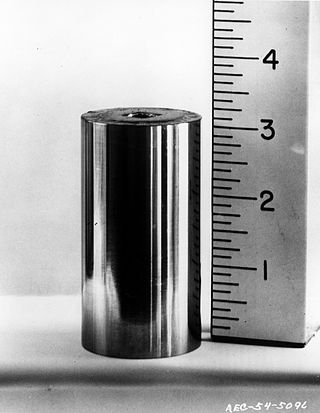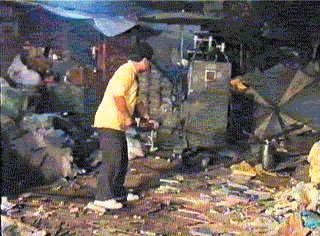Background radiation is a measure of the level of ionizing radiation present in the environment at a particular location which is not due to deliberate introduction of radiation sources.

Nuclear fallout is the residual radioactive material propelled into the upper atmosphere following a nuclear blast, so called because it "falls out" of the sky after the explosion and the shock wave has passed. It commonly refers to the radioactive dust and ash created when a nuclear weapon explodes. The amount and spread of fallout is a product of the size of the weapon and the altitude at which it is detonated. Fallout may get entrained with the products of a pyrocumulus cloud and fall as black rain. This radioactive dust, usually consisting of fission products mixed with bystanding atoms that are neutron-activated by exposure, is a form of radioactive contamination.
A dirty bomb or radiological dispersal device is a radiological weapon that combines radioactive material with conventional explosives. The purpose of the weapon is to contaminate the area around the dispersal agent/conventional explosion with radioactive material, serving primarily as an area denial device against civilians. It is not to be confused with a nuclear explosion, such as a fission bomb, which produces blast effects far in excess of what is achievable by the use of conventional explosives. Unlike the cloud of radiation from a typical fission bomb, a dirty bomb's radiation can be dispersed only within a few hundred meters or a few miles of the explosion.
Ionizing radiation, including nuclear radiation, consists of subatomic particles or electromagnetic waves that have sufficient energy to ionize atoms or molecules by detaching electrons from them. Some particles can travel up to 99% of the speed of light, and the electromagnetic waves are on the high-energy portion of the electromagnetic spectrum.

A nuclear and radiation accident is defined by the International Atomic Energy Agency (IAEA) as "an event that has led to significant consequences to people, the environment or the facility. Examples include lethal effects to individuals, large radioactivity release to the environment, reactor core melt." The prime example of a "major nuclear accident" is one in which a reactor core is damaged and significant amounts of radioactive isotopes are released, such as in the Chernobyl disaster in 1986 and Fukushima nuclear disaster in 2011.

Radioactive contamination, also called radiological pollution, is the deposition of, or presence of radioactive substances on surfaces or within solids, liquids, or gases, where their presence is unintended or undesirable.

The Goiânia accident was a radioactive contamination accident that occurred on September 13, 1987, in Goiânia, Goiás, Brazil, after an unsecured radiotherapy source was stolen from an abandoned hospital site in the city. It was subsequently handled by many people, resulting in four deaths. About 112,000 people were examined for radioactive contamination and 249 of them were found to have been contaminated.

The Mayak Production Association is one of the largest nuclear facilities in the Russian Federation, housing a reprocessing plant. The closest settlements are Ozyorsk to the northwest and Novogornyi to the south.

Caesium-137, cesium-137 (US), or radiocaesium, is a radioactive isotope of caesium that is formed as one of the more common fission products by the nuclear fission of uranium-235 and other fissionable isotopes in nuclear reactors and nuclear weapons. Trace quantities also originate from spontaneous fission of uranium-238. It is among the most problematic of the short-to-medium-lifetime fission products. Caesium-137 has a relatively low boiling point of 671 °C (1,240 °F) and easily becomes volatile when released suddenly at high temperature, as in the case of the Chernobyl nuclear accident and with atomic explosions, and can travel very long distances in the air. After being deposited onto the soil as radioactive fallout, it moves and spreads easily in the environment because of the high water solubility of caesium's most common chemical compounds, which are salts. Caesium-137 was discovered by Glenn T. Seaborg and Margaret Melhase.
Radioactive scrap metal is created when radioactive material enters the metal recycling process and contaminates scrap metal.

This is a list of criminal acts intentionally involving radioactive substances. Inclusion in this list does not necessarily imply that anyone involved was guilty of a crime. For accidents or crimes that involved radioactive substances unbeknownst to those involved, see the Nuclear and radiation accidents and incidents.

The Kyshtym disaster, sometimes referred to as the Mayak disaster or Ozyorsk disaster in newer sources, was a radioactive contamination accident that occurred on 29 September 1957 at Mayak, a plutonium production site for nuclear weapons and nuclear fuel reprocessing plant located in the closed city of Chelyabinsk-40 in Chelyabinsk Oblast, Russian SFSR, Soviet Union.

Between March and July 1962, a radiation incident in Mexico City occurred when a ten-year-old boy took home an industrial radiography source that was not contained in its proper shielding. Five individuals received significant overdoses of radiation from the 200-gigabecquerel cobalt-60 capsule, four of whom died.

The radiation effects from the Fukushima Daiichi nuclear disaster are the observed and predicted effects as a result of the release of radioactive isotopes from the Fukushima Daiichii Nuclear Power Plant following the 2011 Tōhoku 9.0 magnitude earthquake and tsunami. The release of radioactive isotopes from reactor containment vessels was a result of venting in order to reduce gaseous pressure, and the discharge of coolant water into the sea. This resulted in Japanese authorities implementing a 30-km exclusion zone around the power plant and the continued displacement of approximately 156,000 people as of early 2013. The number of evacuees has declined to 49,492 as of March 2018. Radioactive particles from the incident, including iodine-131 and caesium-134/137, have since been detected at atomospheric radionuclide sampling stations around the world, including in California and the Pacific Ocean.

A radiation accident occurred in Samut Prakan Province, Thailand in January–February 2000. The accident happened when an insecurely stored unlicensed cobalt-60 radiation source was recovered by scrap metal collectors who, together with a scrapyard worker, subsequently dismantled the container, unknowingly exposing themselves and others nearby to ionizing radiation. Over the following weeks, those exposed developed symptoms of radiation sickness and eventually sought medical attention. The Office of Atomic Energy for Peace (OAEP), Thailand's nuclear regulatory agency, was notified when doctors came to suspect radiation injury, some 17 days after the initial exposure. The OAEP sent an emergency response team to locate and contain the radiation source, which was estimated to have an activity of 15.7 terabecquerels (420 Ci), and was eventually traced to its owner. Investigations found failure to ensure secure storage of the radiation source to be the root cause of the accident, which resulted in ten people being hospitalized for radiation injury, three of whom died, as well as the potentially significant exposure of 1,872 people.
Exposure to ionizing radiation is known to increase the future incidence of cancer, particularly leukemia. The mechanism by which this occurs is well understood, but quantitative models predicting the level of risk remain controversial. The most widely accepted model posits that the incidence of cancers due to ionizing radiation increases linearly with effective radiation dose at a rate of 5.5% per sievert; if correct, natural background radiation is the most hazardous source of radiation to general public health, followed by medical imaging as a close second. Additionally, the vast majority of non-invasive cancers are non-melanoma skin cancers caused by ultraviolet radiation. Non-ionizing radio frequency radiation from mobile phones, electric power transmission, and other similar sources have been investigated as a possible carcinogen by the WHO's International Agency for Research on Cancer, but to date, no evidence of this has been observed.

A radioactive source is a known quantity of a radionuclide which emits ionizing radiation, typically one or more of the radiation types gamma rays, alpha particles, beta particles, and neutron radiation.
Sometime between 10 and 16 January 2023, a radioactive capsule containing caesium-137 was lost from a truck in Western Australia. The capsule was being transported 1,400 kilometres (870 mi) from Rio Tinto's Gudai-Darri iron ore mine near Newman to a depot in the Perth suburb of Malaga. The Department of Fire and Emergency Services announced to the public on 27 January that the capsule had gone missing, and that the capsule was potentially deadly and could cause burns and radiation sickness. It was discovered on the side of the road near Newman on 1 February.











